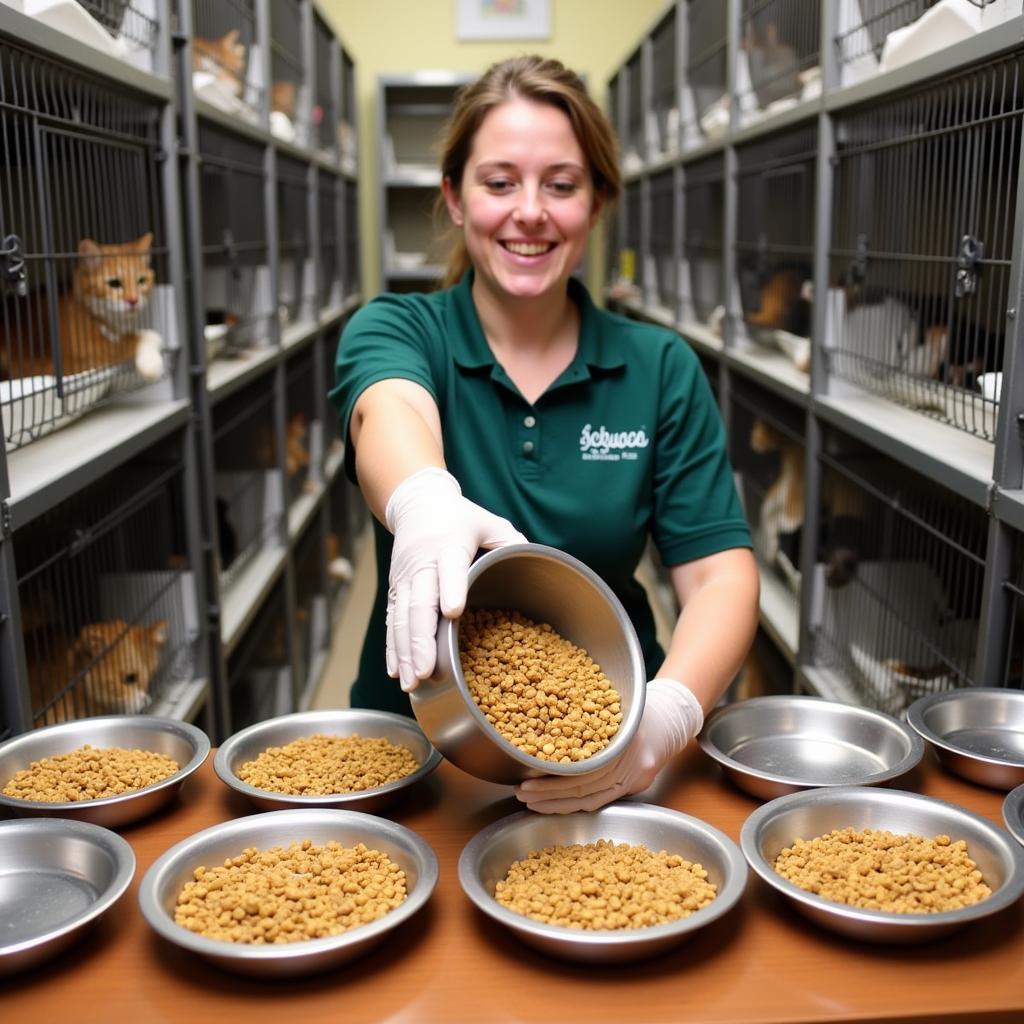The term “Cat Food Insecurity” might seem unusual at first glance. After all, we often picture cats as independent creatures, skilled hunters who can easily fend for themselves. However, the reality is that a significant number of cats rely entirely on their human caretakers for food, and when those caretakers struggle to put food on the table, our feline companions often feel the impact.
What Does Cat Food Insecurity Look Like?
Cat food insecurity exists on a spectrum, ranging from occasional shortages of food to prolonged periods where a cat is chronically underfed. Here are some signs that a cat might be experiencing food insecurity:
- Rapid weight loss: A noticeable decrease in a cat’s weight is a major red flag.
- Increased scavenging: A cat experiencing food insecurity might start exhibiting behaviors like digging in the trash or trying to steal food.
- Lethargy and weakness: Lack of proper nutrition can lead to lethargy and decreased energy levels in cats.
- Changes in coat condition: A cat’s fur might become dull, matted, or start thinning out due to inadequate nutrition.
 Volunteer pouring food at animal shelter
Volunteer pouring food at animal shelter
The Underlying Causes of Cat Food Insecurity
Cat food insecurity stems from a complex web of social and economic factors. Just as food insecurity affects people from all walks of life, it can impact cats in various living situations.
- Financial hardship: For many cat owners, providing adequate food for their feline companions becomes a struggle during times of financial strain. Unexpected job loss, medical expenses, or simply the rising cost of living can put a strain on pet owners, making it difficult to afford pet food.
- Lack of access to resources: In some areas, access to affordable pet food might be limited. This can be due to a lack of pet supply stores, limited transportation options, or the high cost of pet food in a particular region.
- Natural disasters and emergencies: In the aftermath of a natural disaster or during other emergencies, access to pet food can become disrupted, leading to food insecurity among cats.
How Can We Combat Cat Food Insecurity?
Addressing cat food insecurity requires a multifaceted approach. Here are some ways we can help:
- Supporting animal shelters and rescue organizations: Donating to or volunteering at your local animal shelter or rescue organization is a direct way to help cats in need. These organizations rely heavily on donations to provide food, shelter, and care for animals. Consider checking their websites for wishlists or donation drives.
- Raising awareness about pet food banks: Many communities have pet food banks that provide free or low-cost pet food to families in need. Spreading the word about these resources can help connect pet owners with the assistance they need.
- Advocating for policy changes: Supporting policies that address the root causes of food insecurity, such as poverty and lack of access to affordable housing, can have a positive ripple effect, benefiting both people and their pets.
Finding Resources in Your Community
If you’re facing cat food insecurity or want to help, several resources are available:
- The Sandstone Food Shelf: This organization provides food assistance to families and individuals in need, including pet food.
- Life Cathedral Food Pantry – Food Distribution Center: This pantry offers a range of food assistance programs, and they often have pet food available.
- Hackensack Food Pantry: Located in Hackensack, this pantry provides groceries and pet food to those experiencing food insecurity.
A Collective Effort for Our Feline Friends
Cat food insecurity is a solvable problem. By understanding its causes, raising awareness, and supporting initiatives that provide assistance, we can make a difference in the lives of cats and ensure that our feline companions receive the nourishment they deserve. If you are struggling to feed your cat, please reach out for help. There are people and organizations ready to assist you.
FAQs about Cat Food Insecurity
1. What should I do if I can’t afford cat food?
Don’t hesitate to contact local animal shelters, rescue organizations, or pet food banks. Many offer free or low-cost food assistance for those in need.
2. Can I donate open bags of cat food?
While it’s best to check with each organization, most prefer unopened bags of food to ensure freshness and quality.
3. How can I find a pet food bank near me?
You can search online for “pet food banks near me” or check with your local animal shelter for recommendations.
4. Is there a government program that helps with pet food costs?
Currently, there isn’t a dedicated government program for pet food assistance. However, you can explore options like SNAP or other food assistance programs that might offer some support.
5. What are some affordable cat food options?
While it’s essential to prioritize your cat’s nutritional needs, consider checking with your veterinarian for recommendations on affordable yet nutritious cat food brands.
For immediate assistance, please contact us at Phone Number: 02437655121, Email: [email protected]. You can also visit us at 3PGH+8R9, ĐT70A, thôn Trung, Bắc Từ Liêm, Hà Nội, Việt Nam. Our customer support team is available 24/7 to assist you.